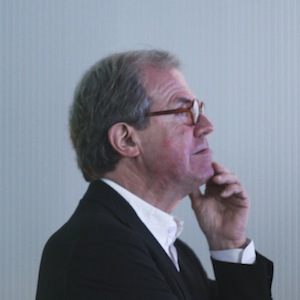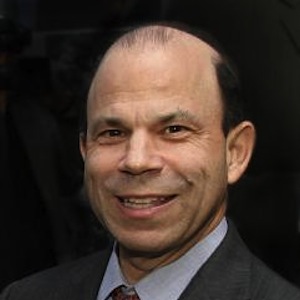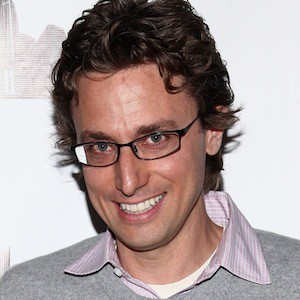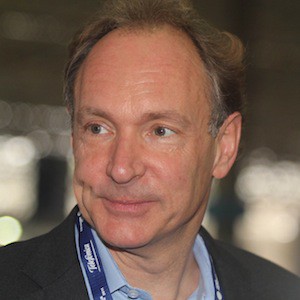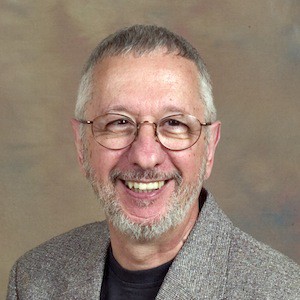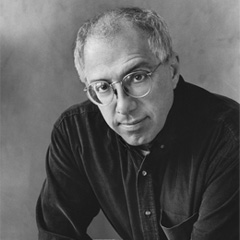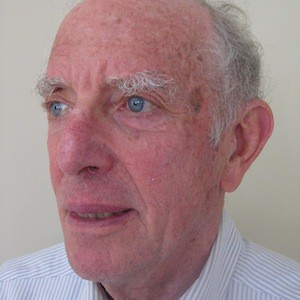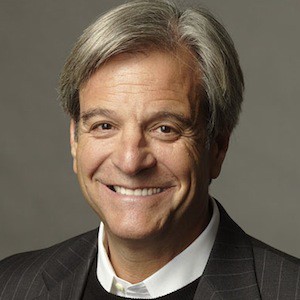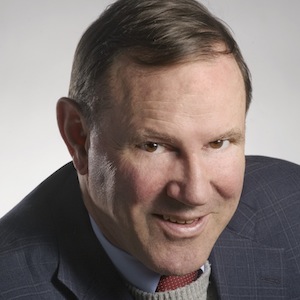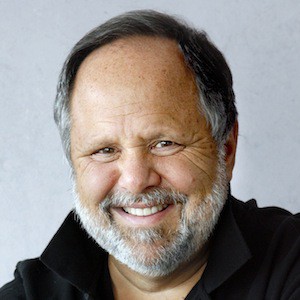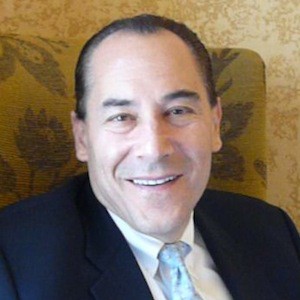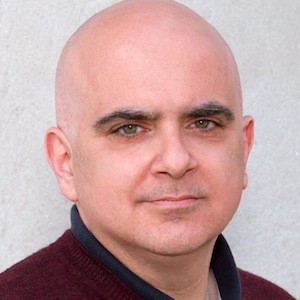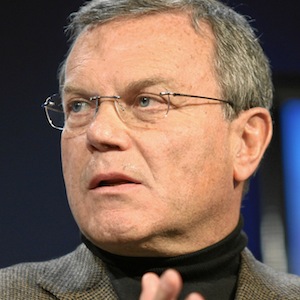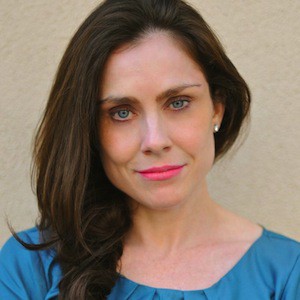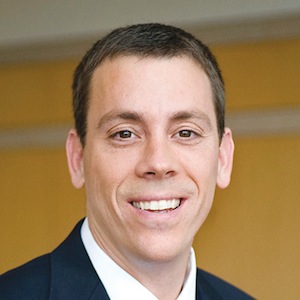Paul: So it is April 11, 2013. Paul Sagan and John Huey, we’re on the campus of MIT at the Media Lab in Cambridge with Nicholas Negroponte. Welcome.
Nicholas: Thank you.
Paul: So one of the questions we’ve started with is, “What was your first time when you saw or had a glimpse into what digital technology was going to do to the media business or even the news business?”
Nicholas: I came to MIT in 1961, so I was here when Norbert Weiner was still alive. Actually, he died that year. Then I was doing my thesis work in areas that had to do with computers. As far back as ’65 I was using computers every day. We had just invented time sharing, so people could go up to terminals and type things in. You could search databases. The first time it was news centric, that I could actually go and look up news stories, was in the days of teletext and videotex. Maybe Lexis had already started, Lexis and Nexis, so that puts it early 70s.
Paul: ’70s into the ’80s.
Nicholas: That puts it in the early ’70s. The ’80s, a lot had already happened, but it was the early mid ’70s.
Paul: That’s pre the web, pre dial up, pre proprietary services.
Nicholas: Well, it wasn’t pre dial up, but it was pre domain names, because a student of mine designed and built the Domain Name Server. I was using what is today called the Internet back in ’70, ’69 ’70. But it was really Multix that was loosely connected with three other computers, and Russell Newman, who’s a neighbor, had contracted a man named Licklider. JCR Licklider was very much a mentor and somebody I had worked with. Lick had written a book in, I believe it’s ’65, called “The Future of Libraries.” While libraries isn’t news, necessarily, it was the online nature of it and searching, and news feeds would very quickly be available online. It really for me started to happen in the early ’70s, to see it emerge.
Paul: This is still pre a consumer experience and really pre a B2B experience, even. It was pretty much academically centered.
Nicholas: Well, as you know, the Internet or ARPANET, as it was called, and DARPANET as it was called after that, wasn’t available to companies until the mid ’80s. In fact, it was I think ’87. It wasn’t legal for companies to use it. The reason I know that is that when we opened our doors for business at the Media Lab, which was October 1985, we were fronting for companies to have email addresses, because we, as an academics institution, could have email addresses on the Internet, and companies who funded us could have them. In other words, it wasn’t quite laundering, but it allowed companies to have Internet access. We started in that year, I believe, in ’87, something called “News and the Future,” which for us was the Media Lab’s first real step into the newsroom and news gathering organizations.
Paul: Why did you do that? What did you see?
Nicholas: We did that because we saw the nature of news changing very quickly. We had something called “Television of Tomorrow” that predates it by about two or three years, but that was really the technology about high definition and delivering television over telephone lines. It was very tech oriented. The news in the future, we thought, would be more content oriented. In the case of news in the future, we basically went to media companies and said, “You better hedge against the future and fund us.” I believe that at our peak we must have had 50 or 60.
Paul: I remember some of them.
Nicholas: You would be hard pressed to tell me one that wasn’t, in other words, everybody. Time and Warner were separate still at the time.
John: Warner had QUBE and Time had (Time) Teletext. Times Mirror had Gateway. All of those people were…
Nicholas: Every single one of those companies was a member of “News in the Future.” The only one that was a hold out that I don’t think ever was part of it was “The New York Times.” Am I correct? I think it might have been the only one.
Paul: We’ll ask Martin.
Nicholas: You should check. I think so.
John: Do you know why?
Nicholas: I remember in 1981 82 going down to “The New York Times” with Jerry Weisner to see…who was the CEO?
John: Russ Lewis?
Nicholas: No, his wife, might have been former wife, was a reporter in Paris for the Herald Tribune.
Paul: Madison?
John: Sydney Gruson.
Nicholas: Sydney Gruson and Jerry Weisner have this story they’re chatting away about. Then Sydney Gruson looks at me and says, “Young man, what is the future of newspapers?” I said, “Sir, it’s to wrap dead fish.” Jerry Weisner never forgave me for that comment. As we walked out of the building he said, “How could you say that?” When we did our first electronic newspaper here at the media lab, that was really the first web application. I don’t think there had been, really, a previous application, they named it Fish Wrap, sort of in honor of that remark. That goes back to the early ’80s.
Paul: There’s no web threat yet. This is very early. These companies are all here. They understand there’s a future that’s changing somehow. You’ve shown them some of it, yet it didn’t work out so well.
Nicholas: It depends on the companies. Some tried. The Newhouse people, particular Steve…
Paul: Who we spoke to.
John: He mentioned that he came here and this is where he got this.
Nicholas: I think most of the people will tell you that. A lot of them came here.
John: Could you step back just for one second and talk for just a minute or so about the founding of the MIT Media Lab, what it was intended to do, and why it was thusly named?
Nicholas: Sure. Actually, that’s a pretty good topic, and thank you for asking. A couple of things are a bit circumstantial. One is that Jerry Weisner was president. I don’t know if either of you ever had the privilege of knowing him. He was very interested in the arts and in science. His office as president was on the same floor, and if you followed the corridor, it went through my lab to the elevator that he took down to the ground floor where his chauffeur, he was the last president to have a chauffer, Mr. Tibbs, parked his car.
John: So this is a location, location, location.
Nicholas: This is a location story. Jerry would walk with his lunch guests to the car through our lab. Who visits the president of MIT? People you would love to have walk through your lab. Our lab was very photogenic. We were doing a lot of display work, floor to ceiling displays, touch sensitive displays, electronic publishing on screens with images and video all mixed, which back then in the late ’70s was very astonishing. In fact, when we would show somebody an image that had text and a photograph, they would be impressed to see the two on one screen, but then when you touched the photograph, and it turned into video, you would hear sucking in noises. People who go, “Huhh.”
Paul: This was in what year?
Nicholas: This was ’78.
Paul: Wow.
Nicholas: People would be astonished at that sort of thing. When you could move your finger across text and it would say the words and stuff like that. It lent itself to a 30 second experience, and then you could continue to the elevator and go to lunch. It was very accessible. It was very, as I said, photogenic. Over that period, from let’s say ’77 to ’80, I got to know Jerry really well. Some would say he was, in fact, like a father figure. One day he confided in me. He said, “I’m going to retire as president, and I’m not going to become chairman.” Usually the president becomes chairman and the chairman becomes chairman emeritus, and everybody shifts up. He said, “And I’m not going to because Howard Johnson,” who was then the chairman of MIT, was younger than Jerry and doing a wonderful job, and Jerry didn’t want to. He said, “I’m going to go back and do research. The problem is that there’s no lab that I want to go to.” I said, “I have an idea. I’ll build you a lab, and it will be at the intersection of art and science.”
At the time I was the academic head of all of the, let me call them, “extradisciplinary” elements of the School of Architecture and Planning, which included photography, video, computer graphics, graphic design, and then we even had the graduate music program. All of those pieces that were orphans at the institute were academically my charge.
When we decided to build the Media Lab, we took those pieces, and others, and put them together in this thing called the Media Lab, which was very much a salon des refusés, people who were not accepted in their departments. When I went, at the time, to the provost and said, “I’d like to include Seymour Papert and Marvin Minsky in the Media Lab,” they said, “Bless your heart.”
[laughter]
Nicholas: They were troublemakers, and they weren’t necessarily welcome in their home department because they were too edgy, too risky, too outspoken, whatever the right word is. The people who formed the original Media Lab did so in a frictionless fashion, and the statement, the “mission statement,” if you want to call it that, was that the inventors and creative users of new media should be in one place. The example of where that didn’t happen was in television. Engineers invented it and then threw it over the fence, and people used it. The example of where that did happen is photography. If you think of the history of photography, the people who invented it were the creative users, and when you wanted to do something else, you invented more. My argument, had you been in the room and I was trying to persuade you, in 1985, was that the computers would be the same thing. That the future of computers would be driven by the creative users, not computer scientists. That was the basis for the Media Lab.
John: Almost everything you just described hit the retail market again, in terms of both product and rhetoric, in Steve Jobs, 35 years later. The science and art, the touching the screen, but television missed out on it too.
Nicholas: When we opened the building, 1985, he was our speaker. I’ve know Steve very well. Steve, four years before, wrote a $500,000 check to help build the Media Lab, which he could ill afford. He not only was our speaker, but as a side note, our caterer was Martha Stewart, an unknown caterer. [laughter]
John: That is new media.
Nicholas: I said, “Boy, we’ve launched careers.” [laughter]
Paul: High/low.
John: We don’t want to divert into that, [laughs] although after the tape quits rolling, I’d love to hear more about it. Paul, I’m sorry, but I think we may be [crosstalk] .
Nicholas: No, I’m glad you asked. The going to News in the Future was very much on mission, because it was about content and invention simultaneously, and people like Steve Newhouse were leading the pack. A lot of people came to those meetings in a more absorbing and reflective mode and would not go back necessarily and invent things, but it was an era of change. The Web, which was born, and some of the people on the team came right out of the Media Lab. It was born at that time and used here. Tim Berners Lee didn’t have a clue what he was doing. Not a clue. When he came and he did stuff here, I remember seeing him at dinner once. He was the dinner speaker. I said, “Tim, you don’t know what you’ve done. It’s really very important.” I remember having the same conversation in, I want to say 1988, maybe it was 1987, in London, with a group of people who were arguably the inventors of the Internet. Larry Roberts was there, Vint Cerf was there, Bob Kahn was there, Len Klein. It was that group.
I remember it was 40 people. I forget why I was leading the discussion. I said, “How many people will be on the Internet in the year 2000?” The numbers were numbers like 30 million, 40 million. One person, I forget who it was, reached to 100 million and I said I think it’ll be a billion. People said, “You’re joking.”
Paul: Explains why there weren’t enough addresses.
Nicholas: It’s amazing how nobody guessed the extent of it. Really did not.
Paul: Walk us up to that a little bit. The lab launches in ’85 so no web, no proprietary dial up services in any scale quite yet, right? This is pre CompuServ taking off or maybe just starting, no Prodigy, no AOL.
Nicholas: General Electric had a time sharing system available in the early ’70s that people used.
Paul: But not most people.
Nicholas: No. CompuServe must have been around then, too. Maybe ’75. Then there were a few others that came and went. It wasn’t very common. You could argue the media missed the web a little bit because we were very much into interactive television and television on demand and bandwidth compression and some of the people who graduated from here won. [inaudible 18:45] went and worked with Tim at CERN at inception and brought with him some of the graphics and stuff he had learned here. We certainly contributed but didn’t do as much of the invention until it came time to do the applications and I think it’s another case where the creative users became the inventors.
Paul: Describe that. Did that happen in the same lab with the same group of people or a different group?
Nicholas: The lab is a whole building. The building had groups in it and there was one particular group. Actually, they had multiple names but it was called electronic publishing, actually, in its early day and in the same one there was interactive video, which in ’85 was a pretty astonishing name and a pretty astonishing thing to be doing. They co habitated. There was a project called “Advanced Television something” which was similar on the same floor. It happened on one floor in the building that was the media lab.
John: When you’re presiding over all this, and this was an exciting time, obviously, people were getting their own computers in exponential numbers and you’re running the media lab. What was your big extrapolation of where you thought all of this was heading, not just for the news business? Where did you think this was going?
Nicholas: I will answer the question of where I think it was going by not only telling you what I think it was but also there’s real evidence today that that was the case. I thought it was going straight for lifestyle. This was about life, not computing. What was relatively rarefied, people using computers, whether it was the hobbyists first or scientists and so on, was going to, in fact, be a way of life and was going to change the way we did everything from cooking to living to vacationing to communicating just in general. I said back then, before the book being integral, that computers were about living, whatever. Computer science was about life. I forget what the exact quote is, but now it gets thrown back at me a lot because I see it in tweets and so on because when you have a name like Negroponte you don’t get false positives on Google alerts. It’s either my older brother or me so I track these things, not so much narcissistically but because they appear on Flipboard or whatever you’re looking at. I think that was the key, that it was about the quality of life, lifestyle and the way we’d be doing that and the future.
John: So you saw it as the great transformer or the great disruptor?
Nicholas: I didn’t think too much in terms of disruption because it was destiny. I didn’t think of it as a surprise and I think of disruptions as surprises.
John: That gets to one of our big questions.
Paul: Go ahead.
John: We’ve explored all though talking with everyone this concept. In the news business, there is a prevailing theory or myth or whatever that there was this original sin. That tthe original sin was deciding to give it away rather than to charge for it and that that happened in 1994 with Yahoo and Reuters. There’s an alternate theory which is once HTML and the digital file was invented and all news could be put into a digital file, that what followed was inevitable. How different companies or different individuals reacted to it is one thing, but that the trajectory that we were on was inevitable and that where we are is where we’re supposed to be and where we would be.
Nicholas: I certainly prescribe to the inevitability thesis. I don’t believe for a moment that there was a misstep, that if we had not taken it that it would have unfolded differently. Information wanting to be free and all of that theory about it leaking out and having the ability to do so is very true. Even if you buy something, you pay and you follow all of the right economic models, then just the ability to cut and paste and copy and distribute and send and so on is going to create that anyway.
Paul: Only in digital.
Nicholas: Only in digital, yeah.
Paul: If you can take the fish wrap and cut it and have one copy and send it and the ability to do it infinitely it’s a game changer.
Nicholas: That was the inevitable part. Once it went digital and people’s lifestyle was digital. If people didn’t have lifestyles that were digital the fact that you can cut it and paste it and ship it around doesn’t mean much, either. There had to be these things happening in parallel. It’s the inevitability. I think that was clear to people. It was certainly clear to Rupert Murdoch. You look at the people who are doing pretty well in the news areas, even maybe they take losses, they’re people who, I think, subscribe to this is going to happen anyway so how do I participate.
John: Who else would be put in that category?
Nicholas: I would put Jerry (Jerome) Rubin, who died about two years ago, who was at Times Mirror for a while. I certainly put Rupert in it. Some of the people. I think Walter Isaacson certainly falls in that category. It’s funny because it’s on a sharp line because you find people who I think understood it but their organizations didn’t allow them to move.
John: If you look back at the history of this thing, some of the companies that would have appeared to understood it earliest and best and invested first were companies like Tribune and Knight Ridder and Jerry Levin at Time Warner. You had all of them, in one way or another, crashed on the rocks for maybe, as you say, more organizational reasons than technological reasons.
Paul: One of the things that has emerged is a theme because, arguably, Knight Ridder was early and did lots of experimentation.
Nicholas: They did?
Paul: Mercury Center built a prototype of a tablet before you could even build a tablet, even created a lifestyle movie to show.
John: Which is what you was doing in ’78.
Paul: There were lots of models.
Nicholas: Those were a little late, those video prototypes.
Paul: They may have been later but they were still before you could have built one. They were 25 years before the iPad almost and yours were 30. The visions were there. Yet, those companies couldn’t survive through that. Was that because of the inevitability of changing the business model, blowing apart the lifestyle experience, the bundle they had no longer met the lifestyle? Do you think it’s one or the other or the force of both? Then the third thing that’s come up has been not being engineering centric, that the digital piece has been driven so much by companies with lots of engineers and engineers in charge. The media companies, by and large, have few engineers or the few that had some like Knight Ridder, Tribune had some, CNN had some but didn’t stay a leader, would never have put the engineers in charge. They still would have kept them over in the corner. You can look at them but don’t get too close.
Nicholas: Let’s look at one of the biggest players in news today is certainly Google. There’s not a person in Google on the founding team who thought they were at all related to news and they would effect it. It was not a motivation, it was not a purpose. They didn’t think they were going to end up doing that. I think what emerged, because you could do these things globally and instantaneously, is quite extraordinary. The people who were running the news organizations became victims pretty quickly because they weren’t as general and as expandable. Yeah, you’re right, they were not run by engineering people, but had they been I’m not so sure it would have been different. I don’t think back to any one decision where I said, Wow, if Time Inc. or someone had only done this or only done what I said or only listened to someone then it would all be different.” There really is this other thing happening that you’re not part of. It’s trains and airplanes and something else was going on and this other thing was happening anyway.
Paul: Our favorite metaphor has been swimmers and tide. You have some pretty good athletes swimming, but the current was so strong it just carried the strong ones and the weak ones out.
Nicholas: But it’s a little bit like being in the smoke signal business when somebody is inventing the telegraph. They are sort of related but not related and there are actually texts as to why the telegraph was a bad idea and smoke signals were better that had to do with your enemy couldn’t cut the line and you could still get the signals across. There were real arguments made for that.
John: Wind could be a problem.
Nicholas: Yeah, exactly. [laughs] I think there was an unrelated concurrency that changed lots of things. It’s not just the news industry. Look at all the things that have changed. [crosstalk]
Nicholas: Yeah, retail. Could Wal Mart do something different today? Yes, you could do something different. I just said it to the CEO of Wal Mart, and he didn’t think it was particularly interesting, I said, “There are ways of printing meat, literally steaks. If you were to take a lead in this…” They have a large food business. “…you could actually deliver food electronically.” He just wasn’t interested. He just was not interested.
Paul: It doesn’t sound appetizing.
Nicholas: The disinterest was… [crosstalk]
Paul: I get your point completely.
John Huey: Wal Mart rode one wave of computerization in that they…
Paul: And Amazon.
John: …had the data. They always knew what everything was in. Then Amazon took their model and put it on top of that.
Paul: Let’s go back to the Google News point for a minute. So they’re big in news in terms that many people go there as their first news page or Yahoo would be another place that people might go. Certainly Google has taken the lion’s share of advertising which drove a lot of traditional print media before, but they don’t produce anything. They don’t actually produce the stories. It begs the question, “Who is going to do that, and where do you see that coming from?”
Nicholas: Let’s tease them apart. We can at least categorize three of them. One is what I’ll call the long form. It doesn’t have to be investigative, but some kind of in depth treatment of something. That’s sort of one question. The kind of news alerts which is kind of the other extreme…
Paul: So one is total commodity, and one is about as far as you can be from it.
Nicholas: Right. Then there is probably a space in the middle which is the more typical news story. The one that’s taking the hit right now is the long form, because that used to be kind of subsidized by the others.
Paul: Absolutely.
John: That’s what I do for a living.
Nicholas: Right. It’s a really interesting issue, because there are two parts to the long form. We only think of one part, which is the consumption side. The amount of time it takes to cue it and the effort and deliberation and research and reflection and seeing it from as many points of view as possible is really important. That’s the part you don’t want to ever lose, but it’s the one that’s at risk. The other stuff I don’t care too much about, because I trust that it will exist in some way. The question is, “How do you make sure that happens?” Everybody’s answer seems to be by strengthening the business models of the organizations that used to do it so that their business can still…I’ve started to think a little bit differently about it because there are some examples, and the BBC may be one of them, where some material is created sort of more through the public domain.
NPR or WBUR, why listen to any other radio station in greater Boston that BUR? So these are not civic but it’s not private enterprise, it’s a public resource. Maybe it has some form of advertising or the equivalent, but I’m beginning to look at that much more as a way of not just get alerts in the middle form but some more reflective and long form stuff. Maybe this is going to shift more from the private to the public sector in some way over time. I’m sure people discuss that at your (Shorenstein) Center.
John: The philanthropic model, the public model, the non economic but strategically linked model, there are all kinds of new models that already operating with no clear verdict on what will stick and what won’t. If you look back on it all, do you have in your mind mileposts along the way that mark eras or epochs or big changes? If you do, great, could you share them with us? If you don’t, can you extrapolate from where we are now to what you think the next stage might be?
Nicholas: Clearly, the web marked an epic. That’s very clear. The presence of Google marked another one. That really changed things. More recently it’s a little harder. I’m always interested in what happens in parallel unrelated, so the movement away from film to digital photography. It’s arguably unrelated, but, yes, they might be pictures and stories, but boy has that really changed things. It’s just like we go back to personal computers in their early days. People tend to forget that, in the United States, we had the breakup of AT&T at the same time. You had other things that happened that changed telecommunications in parallel with personal computing.
Another coincidence that people conveniently forget is when Europe deregulated their telephone system, it was exactly when cell phones were invented. It’s not that one caused the other, but since they occurred at the same point in history, then the way to create more phone companies and more privatization was, guess what, you can have cell phones.
Europe became very advanced with cell phones, and we didn’t because we had phone booths on every corner, and you could get phones really easily. Different things happen. I think now the changes that are going to happen, whether it’s what’s in your pocket or the amount of intelligence in the system, if you extrapolate, it’s not going to be that big until we can start getting stuff directly into the body. When you can squirt things into your brain and stuff without having to go through the human sensory system, it’s a big change. Maybe you’ll put on your little news cap in the morning for 10 seconds and that’s it.
Paul: After you’ve printed your bacon.
Nicholas: After you’ve printed your bacon, right, if you have to eat at all. [laughs] There are some pretty big changes that are kind of unrelated to extrapolating the digital world as we know it, wireless or wired.
John: So do you think that world has pretty much reached its plateau here?
Nicholas: Has it become plastics?
Paul: Yeah.
Nicholas: Yes, it has. Insofar as when we look back, I think the big changes were either previously leading up to now, because they’re really quite extraordinary the things that are happening, so by comparison they’ll be small. Sort of we’re silicone and biology…
John: Yeah. If that’s true, that has much more profound implications than what we’re talking about here in our little corner of the world. That has big economic implication, because this whole world drove the economy for 30 years or 40 years. I assume it…
Nicholas: It’s not disappearing. I don’t want to suggest that it is.
John: No, no, but the explosive growth of that whole new industry really changed our economic trajectory for that whole period. I’m assuming you’re now saying that’s going to bio…
Nicholas: In terms of technical innovation and surprise, I’m constantly impressed by the new apps and the new things. But they’re all…
John: Lifestyle, that’s all lifestyle. Wouldn’t you say?
Nicholas: Yeah, modest changes in lifestyle.
John: It’s easier to find your restaurant every day. It’s easier to get around, know where the tea is.
Paul: But refinements.
John: Yeah.
Nicholas: I think it’s in a stage. It’s attenuating in terms of the big changes.
John: So what are you personally working on right now?
Nicholas: Personally, for the past seven years, I’ve been working on children and learning in developing countries and in the past two years focused on an experiment, on a rollout. “One Laptop Per Child,” everything you see behind me, is a really project. It was about a billion dollars. Most people have no idea of the scale of it. The last couple of years I’ve done a very small experiment to see if children can learn how to read on their own, because of the 60 million kids who do not go to school, most people don’t appreciate that most of them, even it’s only 40 million but it’s probably closer to 50 million, don’t go to school because there isn’t one. If there is no school, what do you do? The question is, “What can the kids do on their own? Can kids learn how to read, for example?” It’s a very specific question because of the cliché, but a very true one, if you can learn to read, you can read to learn.
So there’s a cusp. As part of that, we dropped off in two villages in Africa that had no literacy, no adults, no children, no words, no road signs, no printed matter, no television or telephone, nothing. We dropped off as many tablets as there were kids. The tablets were in closed boxes without instructions, with no teachers.
Paul Sagan: This was Cynthia?
Nicholas: Cynthia and Maryanne Wolfe.
John: We met Cynthia.
Nicholas: Did you talk to Cynthia about…
Paul Sagan: Not for this.
John: No, but we’ve both met her.
Paul: She’s married to Bobby.
Nicholas: I know her husband is your CTO?
Paul: Head of networks and engineering, so he runs everything that’s technical.
Nicholas: At any rate, the experiment has worked sufficiently that, about a month ago, we converted it into the next X Prize. We created a 15 million dollar prize for anybody who could basically do what we did, enough to prove that it was doable. And now, if you could do it at scale were the premises. I’ve spent my time on that sort of thing, and because of the X prize, I’ve suddenly become a source instead of a sink. It’s nice to be on the other side of the equation. [laughs] That’s where I’ve spent my time.
